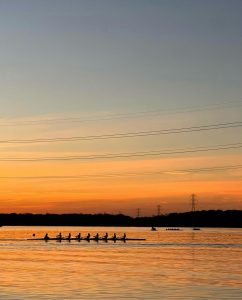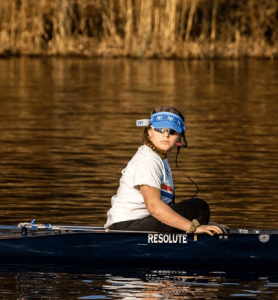 Attention. Ready. Row! Those are the words we wait for. Those are the words we respond to.
Attention. Ready. Row! Those are the words we wait for. Those are the words we respond to.
Rowing is technically a year-round sport. We row and race in the fall and spend our winters conditioning our bodies. But spring is the biggest season of the year.
This winter we have spent four months training indoors to get ourselves in shape for the spring. As a rower, winter season means months of erging thousands of meters, weightlifting countless pounds and running hundreds of miles. Hours of hard work met with lots of sweat and lots of tears.
 As a coxswain, the winter months are spent assisting the coach in keeping track of the rower’s erg scores, motivating our teammates, facilitating a smooth-running practice schedule and fine tuning our own leaderships skills, so that when spring comes, we are ready to cox the boat. In total, the winter season is 6-days a week, for nearly 3 hours each day from November to March. As the winter season comes to an end, we are restless to get back to the Caspersen Boathouse and the lake.
As a coxswain, the winter months are spent assisting the coach in keeping track of the rower’s erg scores, motivating our teammates, facilitating a smooth-running practice schedule and fine tuning our own leaderships skills, so that when spring comes, we are ready to cox the boat. In total, the winter season is 6-days a week, for nearly 3 hours each day from November to March. As the winter season comes to an end, we are restless to get back to the Caspersen Boathouse and the lake.
The week of March 4th marks the official start of the spring season. After months of conditioning our bodies and minds, we finally get to put ourselves to the ultimate test and get back out on the lake. Just like winter, practice is rain or shine, 6-days per week. Rain or shine, we are out on the water rowing. We row boats that seat eight or four rowers; not including the coxswain. These boats are called shells. We push through our fatigue so much that our hands start to blister and bleed. As much as it hurts sometimes, being on the water is the best part of the sport.
 As a team, we review videos of our technique, identifying and altering any movement that may be slowing down the boat. Technique is just as, if not more important, than our power. Rowing is just as much a mental sport as it is a sport of strength.
As a team, we review videos of our technique, identifying and altering any movement that may be slowing down the boat. Technique is just as, if not more important, than our power. Rowing is just as much a mental sport as it is a sport of strength.
During a typical practice, we circle the entire lake over and over again, running drills while our coxswain is leading us. The coxswain steers the boat and directs the rowers’ movements. He/she sits in the stern of the boat, facing all of the rowers. Unlike the rowers, who sit on sliding seats, much like an erg, the coxswain sits on a fixed seat partially enclosed in the either the bow or stern of the boat depending on the type of boat. They wear a headset and microphone so that the rowers can hear the calls. They call stroke rates, monitor technique, and keep the rowers in sync by motivating the team to push through their pain; they are the voice of the boat. Every coxswain has a different way to lead their boat, some of the most common calls are, “together”, “legs down”, and “breathe here”. During races, coxswains make sure the race plan is executed, ensure safety of the rowers, and help the boat to maximize speed. They are essentially, the coaches of their boats.
 We train all season to act as one. Each rower must follow the rower in front of them perfectly, to ensure the boat is in constant sync. When regatta days finally come, we line up to the starting line, and wait for the horn to go off. “Attention. Ready. Row!” And then it’s a mad rush to the finish line. We push ourselves and our teammates beyond our breaking point. Each stroke gets you closer to a victory. The coxswain is steering and coaching the rowers every step of the way, towards the finish. We cross the 1000-meter line, then the 500-meter line, and then comes the final stretch, when we press as hard as we can and speed up all while staying in sync as a team. The coxswain calls for the team to give everything they have, for them to work together to get ahead. This is the moment that makes or breaks the race. The final sprint. In this moment you are in such intense pain and exhaustion you practically leave your body, and it feels like the race will never end.
We train all season to act as one. Each rower must follow the rower in front of them perfectly, to ensure the boat is in constant sync. When regatta days finally come, we line up to the starting line, and wait for the horn to go off. “Attention. Ready. Row!” And then it’s a mad rush to the finish line. We push ourselves and our teammates beyond our breaking point. Each stroke gets you closer to a victory. The coxswain is steering and coaching the rowers every step of the way, towards the finish. We cross the 1000-meter line, then the 500-meter line, and then comes the final stretch, when we press as hard as we can and speed up all while staying in sync as a team. The coxswain calls for the team to give everything they have, for them to work together to get ahead. This is the moment that makes or breaks the race. The final sprint. In this moment you are in such intense pain and exhaustion you practically leave your body, and it feels like the race will never end.
Then the coxswain says “off,” and you’re done. The race is over. Months of training on and off
the water has paid off, all for that 7-minute race. You row back to the dock and put the boat away, the adrenaline from earlier having completely worn off. And then the cycle repeats, and you keep training and pushing yourself to your breaking point.
In the spring there are regattas every weekend. You spend all of spring leading up to June, perfecting every aspect of your stroke, getting stronger and faster. Then comes Nationals. Every year, the best of the best all competes in one huge race. As Nationals approaches in less than 100 days, we begin to prepare. Nationals is the highlight and most exciting part of the year. It’s streamed on live TV, and rowers get to skip school for a week and this year, fly out to Sarasota, Florida.
We hope to make Mercer proud and bring home a few medals this year.

